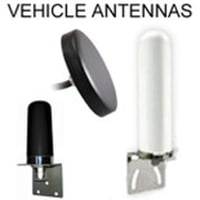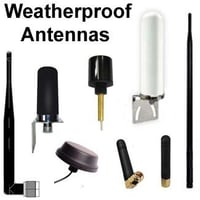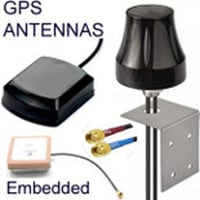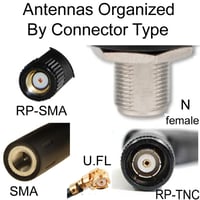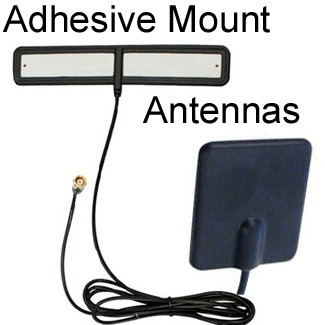Antennas: WeatherProof & Marine
Weatherproof & Marine Antennas:
Marine antennas are weatherproof antennas that are specifically used in a marine setting. This could be:
- Coastal
- In-shore
- Open sea
- Lakes
- Rivers
- Canals
They are designed and manufactured to be able to withstand conditions where the antenna is likely to be exposed to water, sunlight, and humidity as well as other adverse environmental exposures that are capable of aging or frankly damaging an antenna.
Marine antennas are essential for communication and connectivity while on open water and are designed to remain operable in a moisture-saturated environment where salt air, UV-exposure, wind, and rough conditions cause antennas to corrode quickly. They also have to be able to withstand impacts and jolts that inevitably occur due to the vessel traversing rolling waves. Like weatherproof antennas, the materials used are strong and impact resistant.
Marine antennas are typically mounted high on the mast of vessels, and so require strong materials and structural reinforcement to remain functional for a prolonged period.
- VHF radio antennas are required, at a minimum, for VHF radio communication which is the standard frequency band for vessels of all sizes. VHF antennas will be needed for both mast mounted and handheld communication.
- Universal Shipborne Automatic Identification System (AIS) antennas also use marine VHF channels and make boats universally identifiable to other vessels.
Many boats, yachts, and ships will also carry cellular, GPS, and WiFi marine antennas onboard too and can be retrofitted to harness these technologies.
These outdoor antennas are available across a range of antenna types and frequencies as listed below, but are consistent in their superior longevity and performance in an marine setting. By selecting a weatherproof antenna the performance of a radio system or wireless network can be protected from costly downtime and the frequent replacement of corroded antennas.
They are ruggedized and use durable water and corrosion-resistant materials throughout their structure as well as being well-sealed and waterproof. These antennas usually utilize tough plastics and fiberglass for their radome, while the inner resonant elements of the antenna are made from corrosion-resistant metals like brass and plated with inert metals like silver. To protect the antenna from impacts the radome may also be lined and filled with foam. Antenna cables and 50-Ohm connectors for these weather-resistant antennas are selected for their fatigue resistance and are protected from environmental exposure using O-ring seals.
RoHS and Conflict Minerals regulation-compliant marine antennas and weatherproof antennas.
Our selection of high quality weatherproof and marine antennas are built to the highest standards of fabrication with materials of good provenance and quality. All of our antennas are supplied, distributed, and retailed in line with relevant national and international legislation including:
- Directive 2002/95/EC, the Restriction of Hazardous Substances (RoHS) directive, is European Union legislation that limits the use of several hazardous materials in electrical and electronic products (EEE).
- The Conflict Minerals Regulation (2021) is another EU law that proscribes the use of Gold, Tin, Tungsten, and Tantalum (metals that are widely used in the electronics industry) from sources that are linked to conflict and forced labor.
- Section 1502 of the Dodd-Frank Act is a piece of domestic legislation that also deals with the use of the 3TG (Tungsten, Tin, Tantalum, and Gold) metals in electronics.
Materials used in marine antennas
The higher-end fiberglass and steel waterproof / weatherproof antennas, being resistant to rust and corrosion, along with their strength, durability and flexibility, make them ideal for long length rod antennas mounted vertically. They are commonly used in marine applications.
- Fiberglass The antenna wire is wound inside a fiberglass rod to protect it from corrosion. Unlike pure metal fiberglass is not corroded by sea water, making it suitable for marine applications. Fiberglass is a material made of thermal set plastic reinforced with woven glass fibers. Fiberglass has a high tensile strength, with good chemical and heat resistant properties ideal for weatherproofing electrical equipment. In addition, fiberglass has a low dielectric constant, and low moisture gain.
- Stainless steel is used to make parts of fiberglass antennas rust resistant, and to make the mounts for marine antennas resistant to rust and sea water corrosion. Stainless steel is a corrosion resistant alloy of steel doped with 10% Nickel and at least 18% Chromium. The Chromium forms a thin invisible layer of complex chromium oxide when exposed to air on the surface of the alloy. This layer prevents any further oxidation and any corrosion. Chromium is responsible for the stainless steel’s luster and rust resistance. The Nickel adds strength to the alloy.
- Polyurethane foam is used to add additional insulation and impact protection to marine antennas. Injected expanded foams are closed cell and hydrophobic as well as being permeable to radio signals.
Key types of weatherproof antenna
Antennas used for outdoor and marine installations are diverse. They are installed for a variety of purposes, not only wireless networking but also radiocommunication and radio navigation. All antennas connect by standard 50 Ohm radio frequency connectors including SMA, RP SMA, N-Type, and TNC connectors for a mechanically and electrically secure connection.
[A] Weatherproof monopole antennas consist of a rod conducting element, mounted perpendicular to a conductive ground plane. Monopole antennas are omnidirectional antennas, able to send and receive signals in all directions around its axis. The rod is an open resonator, and the wavelength of its fundamental frequency determines its length. Quarter wave monopole antennas are common.
[B] Weatherproof dipole antennas are another simple omnidirectional antenna design, consisting of paired conducting elements that are separated at their mid-point by a feedline. The antenna elements may be rods or wires. The wavelength of their target frequency determines the length of the elements. They have a range of designs and radomes and can be multiplied and housed in a single radome to create dual-band marine antennas or multi-band weatherproof antennas.
[C] Collinear array marine antennas are a common type of marine antenna that is favored for its height durability and performance at a range of frequencies. These omnidirectional antennas consist of multiple quarter-wave or dipole antenna elements. The elements are arranged along the linear axis of the antenna (stacked), this has the effect of increasing the overall gain of the antenna on the horizontal plane. These are the ideal choice for high gain omnidirectional marine antennas and are commonly used for VHF radio as the arrangement supports transmissions over distance. Collinear antennas are usually housed in tough, weatherproof fiberglass which not only protects the antenna but also provides structural support. Fiberglass is not only lightweight, temperature-resistant, and crack-resistant but also highly penetrated by radio frequency signals.
[D] Puck marine antennas are a compact water-resistant design that is ideal for retrofitting yachts and other watercraft for onboard connectivity. They are hockey puck-shaped with a plastic radome that can be readily through-hole mounted on walls and ceilings. The tough weatherproof radome can either house a single type of antenna or dual and multi-band antenna elements.
[E] Weatherproof stub antennas are also known as stubby antennas. They are a small, compact design that has great portability and can be used as replacements for handheld devices. These omnidirectional antennas are quarter-wave monopole antennas with a single connector and typically carry an IP67 rating.
[F] Rubber ducky weatherproof antennas are a popular choice for resilient antennas for handsets and portable radio units that are used at sea or onshore. They are short monopole antennas that have a springy helix base and are coated in rubber. These normal-mode helical antennas serve a range of frequencies and like stubby antennas are quickly attached to handheld and portable radios by screwing them on via the single 50 Ohm connector. The rubber coating of the antenna and its flexibility make it resilient against knocks and impacts.
Weatherproof and marine antenna frequencies
These hardy antennas support the key frequencies used for wireless networking, marine radio communication, and satellite navigation.
(1) Marine VHF 156 and 174 MHz
This is a global radio system for two-way communication for watercraft of all sizes. It is one of the earliest wireless communication systems in the world. Users have access to ship-to-ship and ship-to-shore voice messaging in a band designated by the International Telecommunications Union (ITU) as the Maritime Mobile band.
VHF radio is installed on most seaworthy vessels and is used in navigation, interactions with other vessels, harbors, ports, and marinas, and emergency communications at sea or open water. VHF radio communications are generally limited to the frequencies between 156 and 174 MHz with transmitter power capped at 25 Watts. 1 Watt power is used for shorter-range communication. It is capable of achieving a range of around 100 kilometers (62 miles or 54 nautical miles). The band is divided into 57 VHF channels with Channel 16 as the international calling and distress channel for vessels.
Communications may take place via handheld, portable or fixed VHF radios. A suitable VHF marine antenna is attached to the antenna output on the radio via a suitable connector.
(2) 433 MHz marine antenna
This is a license-free UHF frequency band that is designated for Industrial Scientific and Medical purposes in Region 1 and can also be used for license-free voice radio communications (the Low Power Device 433 or LPD433 band). It spans 433.05 MHz to 434.79 MHz.In the US, part of the band is available for licensed Amateur (Ham) Radio use.
Its applications are diverse, ranging from wireless key fobs to amateur satellite communication and Fast Scan TV. The 433 MHz frequency band is especially advantageous for long-distance, low power connectivity and is used for a range of proprietary Low Power Wide Area Networks (LPWAN) applications including LoRa.
(3) Cellular marine antennas - 700 MHz / 860-960 MHz / 1850.2 - 1909.8 MHz / 2600 MHz
The Global System for Mobile Communications is a cellular communications system that operates via second generation (2G) networking. It is still in widespread use in many parts of the world. It delivers digital voice telephony as well as SMS and enhanced data services via Enhanced Data rates for GSM Evolution (EDGE) or the General Packet Radio Service (GPRS). Outdoor GSM antennas can be used to enhance indoor cellular coverage via boosters. There is also long-range GSM that can be used at sea, to deliver vital connectivity between seamen and their loved ones on onshore.
4G LTE delivers wireless broadband connectivity alongside cellular communication and builds on the Third Generation or 3G infrastructure and cellular networking standards developed by the Third Generation Partnership Project (3GPP). It operates across a range of frequencies depending on the region including
(4) GPS marine antennas 1227.60 MHz / 1575.42 MHz
The Global Positioning System (GPS) is the world's foremost satellite radio navigation system and is owned and operated by the United States Government. It harnesses time and positional data transmissions from a constellation of 24 orbiting satellites to deliver time, location, and navigation services via receiving radio devices. GPS signals suffer significant attenuation as they pass through the ionosphere from the satellite to a receiver and so GPS antennas need to be particularly sensitive. They have a variety of applications, including marine and rugged outdoor GPS antenna designs that will provide greater longevity and performance in challenging environments.
(5) Bluetooth marine antennas 2400 MHz
Bluetooth is a widely used Personal Area Network (PAN) technology and is used to provide local connectivity between items like phones, printers, and speakers. Many recreational boaters install Bluetooth on their boats for entertainment purposes. A marine-quality Bluetooth speaker can be installed to deliver coverage onboard. As the 2.4 GHz frequency is also shared by WiFi, many weatherproof 2.4 GHz antennas can be used for both wireless networking technologies.
(6) Marine WiFi antennas 2.4 GHz and 5 GHz
WiFi antennas can be installed outdoors or in marine settings to provide high-performance wireless networking for a large number of devices via rugged weatherproof omnidirectional antennas. WiFi operates at two distinct frequencies. 2.4 GHz WiFi has good coverage and penetration of non-metal structures, whereas 5 GHz WiFi has a shorter range but is capable of much faster speeds.
At sea, satellite broadband can be used to bring internet connectivity required for WiFi onto a boat or ship, this offshore internet can then be distributed via WiFi antennas to where it is needed on board.
Why are weatherproof and marine antennas important?
Weatherproof and marine antennas are designed to resist the process of corrosion
These specialist antennas are necessary because of the exceptionally short lifespan of antennas that lack their design enhancements and protection. Moisture ingress in particular can destroy an antenna within weeks, especially if it is installed in the salty coastal air.
The main mechanism by which marine and outdoor antennas are destroyed is corrosion. It is known for primarily affecting metals (rust, for example) but can affect materials of all kinds as they slowly react with their environment. This degradation is driven by an oxidative process whereby metal compounds are converted into more chemically stable, degraded forms.
Unfortunately, corrosion of an antenna is an inevitability as its constituent components are gradually broken down. The first sign of a problem may be a deterioration of the antenna's performance despite it appearing undamaged. The breakdown of connections and parts also can lead to the generation of interference due to passive intermodulation (PIM) also known as the rusty bolt effect, with corroded materials on the antenna acting as a diode and generating harmonics.
Corrosion is progressive and cannot be remedied or reversed, making prevention all the more important for extending the usable life of the antenna. This primarily involves protecting and sealing the antenna in a radome that does not allow moisture dust or dirt, the primary drivers of corrosion, to get to the antenna elements.
- The challenges of the coastal environment
The abundance of salt-laden seawater makes the coastline an extremely corrosive environment that will degrade all marine infrastructure that comes into contact with it. The aggressiveness of the corrosion process is increased by the presence of atmospheric and industrial pollutants which accelerate the breakdown of electronic devices and their housings.
Contact seawater or saline air drives an electrochemical process on exposed surfaces. The level of salinity, chloride ions, and dissolved oxygen in the water are the key precipitant factors. Early signs of marine corrosion include pitting and localized crevice corrosion due to chloride ions penetrating metal surfaces
Though materials like stainless steel, copper, and brass are used in antennas for boats, yachts, and ships, they will gradually become eroded and high humidity means that moisture will gradually penetrate the antenna. Corrosion also affects the polymer plastics and composite materials that make up the antenna radome.
Other environmental stressors on weatherproof antennas
In addition to moisture and salt, antennas that are installed outside are challenged by these additional environmental factors:
- Dust is a suspension of organic and inorganic particulates in the air. It is continually present and can accumulate on the surfaces, seams, and threading of antennas and connectors. The presence of dust can cause electrical changes in an antenna's performance as well as acting as a humectant on the surfaces where it builds up. A variety of salts are also found in dust and contribute to the development of corrosion.
- Sunlight is a significant contributor to the weathering and aging of antennas. The UV portion of sunlight has a damaging effect on polymer materials like plastics known as photodegradation. This destructive process breaks down the bonds in the plastic leading to cracking of antenna radomes and exposure of the sensitive elements inside. The solar radiation also heats the antenna which is capable of reducing its bandwidth, frequency, and impedance.
- Temperature fluctuations are a critical weathering factor as the seasonal cycling between hot and cold temperatures causes expansion and contraction of materials over time that accelerates their wear and fatigue.
Purchasing an IP rated antenna provides confidence that moisture ingress will be minimized
Ingress Protection ratings provide a sound indicator of the capabilities of an antenna in withstanding physical intrusions and the ingress of liquids and dust. IP ratings are based on standards published by the International Electrotechnical Commission, IEC 60529. By understanding IP codes you can better assess the suitability of an antenna for your outdoor installation.
IP codes use two digits, and in some cases, two supplementary letters to specify the degree of protection an antenna has. The first digit in an IP code specifies the level of protection the antenna has against dust ingress. The second digit is concerned with the ingress of liquids. Weatherproof and marine antennas usually carry the highest ratings, particularly for the ingress of moisture. Expect to encounter the following ratings when purchasing an antenna:
- IP 57: This rating means that the antenna is dust protected (though not dust-tight) and will withstand the ingress of moisture if it is immersed at up to 1 meter in depth for up to 30 minutes.
- IP 67: Weatherproof antennas with this IP rating are dust-tight and able to remain functional after immersion in water of up to 1 meter in depth for up to 30 minutes.
- IP 68: This waterproof rating means that not only is a marine antenna dust-tight but it is also able to withstand immersion at over a meter’s depth of water for over 30 minutes.
An “X” replacing either the first or second digit means that the antenna does not carry an IP rating for dust ingress or moisture ingress.
Frequently asked questions for weatherproof and marine antennas
How long do marine antennas last?
The longevity of a marine antenna will vary according to the type of antenna and the quality of its build. A marine antenna can last only a few months, up to several years, depending on the harshness of the conditions in which it is used.
Even with the best materials and fabrication, a marine antenna will have a greatly shortened lifespan compared to one used in normal conditions due to the level of unrelenting exposure it experiences.
How can I check if a marine antenna needs replacement?
Communication and connectivity when out on open water are often life-saving, making reliable marine antennas a vital component for properly equipping your vessel. Whether your sailing or boating activity is recreational or commercial, your antennas are your primary point of contact with the shore, other vessels, and coastal authorities. It is therefore necessary that you familiarize yourself with the signs that your marine antennas need replacement so that you can remain assured that you can communicate as and when needed in a fast-changing and unpredictable environment.
- Perform a visual check
Inspect the outside of the antenna for corrosion and rust bleed from the radome. Check for cracks in the radome and that the unit is properly oriented and has not been displaced. You should also check that the antenna connectors are properly coupled and not corroded.
- Test your antennas regularly
Before you rely on your radio and antenna for a boating trip it is prudent to test the antenna by attempting to communicate with a base station or boat which is of a known distance. Use a non-emergency channel and test the quality of the transmissions sent and received. If you are using GPS or sonar check the Time to First Fix. WiFi and cellular antennas can be similarly assessed.
- Disconnect and reconnect your radio slowly
Check how the radio signal weakens or disappears from your radio as your antenna is gradually disconnected, also how the signal strengthens as it is gradually reconnected. If signal strength drops off abruptly, this can indicate a problem with either the antenna, its connector, or the cable you are using.
- Consider stowing a backup antenna
Rough weather and challenging seas can throw up all kinds of emergencies and you can easily find yourself with an antenna down. Browse our range of compact marine antennas that make a convenient but reliable back-up for emergencies.
What gain is needed for marine antennas?
Gain is a critical consideration when selecting marine antennas as they often need to be able to send and receive over long distances. An antenna’s gain is a measure of its ability to focus energy, giving the effect of an increase in its transmitting power. It is measured in decibels (dB) A higher gain antenna will send a stronger signal to other vessels and nearby receiving stations. However, a very focused signal on rough and rolling seas may lead to signal fading with an antenna that is extremely focused.
Boats typically use an antenna that has a gain of at least 3 dB and should be mounted at height, ideally at the top of the mast. Taller, collinear VHF marine antennas are capable of achieving higher gain, with an antenna of 4 feet in height having a gain of 3-5 dB and the gain rising by 3dB for every additional foot in height.
What are the features to look for when selecting a marine antenna?
VHF antennas are the primary antenna type used on boats and other seaworthy vessels and need to be capable of supporting communications with other sea vessels and stations onshore. The principles for selecting a VHF antenna also apply to cellular antennas and other waterproof antenna types you may want to install within your boat.
Aside from the gain or decibel rating discussed above, there are other key features to consider when selecting a quality boat antenna.
- Radome materials: like stainless steel and fiberglass can withstand harsh environments where corrosion can quickly destroy the sensitive antenna elements. Fiberglass radomes are resilient against salty marine air. Polyurethane coatings and expanding foam filling can increase the longevity of the antennas. Ethafoam filling will provide impact resistance for the antenna elements and prevents moisture ingress without interfering with the antenna signal.
- Antenna elements: Both the number of antenna elements and materials used in their fabrication will significantly affect the performance of a marine antenna. Copper and brass are most durable and can be further protected by plating with silver. Stainless steel whip antennas may also be used.
- Height of marine antennas: the height of the antenna will determine how far the antenna can see over the horizon, thus determining the antennas transmitting range. Collinear arrays will have multiple elements stacked up one on top of the other which will also determine the height achieved.
- Ingress Protection ratings can help you evaluate the level of protection an antenna will deliver. IP codes consist of two digits that specify the degree of dust protection and moisture protection provided by the antenna. Key ratings for weatherproof antennas are IP57, IP67, and IP68 which typically mean that the antenna will resist moisture even when immersed to more than a meter depth for 30 minutes.
What is the best antenna cable to use with a marine antenna?
LMR coax cable such as LMR 100, LMR 195, LMR 200, and LMR 400 are high-quality cables with a unique proprietary design that has several advantages when used in marine or weatherproof applications:
- Suitable for both indoor and outdoor applications: LMR 100 has resilient PVC or Fire Resistant Polyethylene jacketing that can withstand the extreme marine environment.
- Flexible cable makes routing easy: These cables are known for their flexibility and low bend radius meaning that they can be used for routing while a boat is retrofitted without being damaged.
- Consistently low attenuation: Double shielding of these cables protect them against signal loss which makes all the difference when attempting to utilize a weak GPS or VHF signal. LMR coax has a much lower signal loss, especially over long runs. Alternatives that are often found in marine stores and chandleries include RG-58U, RG-8X, and RG-213.
In conclusion
An antenna with a suitable level of in-built protection is a priority for outdoor and marine networking installations. These weatherproof antennas deliver the IP rated protection needed by antennas that operate in harsh conditions, ensuring that you receive good longevity, excellent performance and value for money from them.
LEARN MORE:

